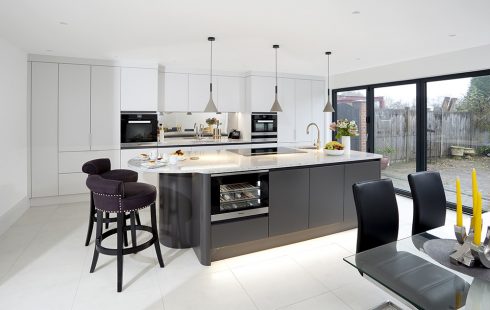
Clean lines reflecting the kitchen
The utility room has evolved to reflect the growing size and versatility of kitchens. The increased stature of the kitchen as a social space in the home has meant that it now incorporates much more than just a washing machine.
Modern kitchens have comfortable seating, audio and video as well as advanced lighting and imaginative architecture like split levels, vaulted ceilings and large openings to the outside.
Utility rooms have a job to do – to take the undesirable elements out of sight!
What is a Utility Room?

A compact but light utility room
The Utility room; defined simply as ‘a room equipped with appliances for washing and other domestic work’ have traditionally been places where the iron and ironing board can be evident, where appliances need not have front panels that match a fitted kitchen, where a sheila maid can be suspended and where the sink can be large and functional – like a butler sink.
It is usually found adjoining the kitchen, most usefully linking it with the outside, and housing the laundry, overspill kitchen appliances – fridges especially, maybe wine racks a separate sink and elements of a boot room or cloakroom. Pets too often find that they take residence here!
Utility rooms have found themselves becoming more important as open plan kitchens shed some of the less attractive detritus of domestic chores and sounded the death knell for storage – leaving nowhere for useful cupboards, racks and shelves
10 good reasons to have a Utility Room

A shiela maid at rest
- To declutter your beautiful, expensive, fitted kitchen
- To have a separate space for Laundry
- To allow noisy machines to run while you’re eating in the kitchen
- To add storage space for cleaning equipment and products, large platters, coats brooms, buckets
- To dry laundry away from (albeit delicious!) kitchen smells
- For pets to eat, sleep and rest
- To allow wet outdoor shoes and clothes to dry
- For cool storage and recycling away from the cooking/family area
- For boilers, water softeners, accumulators and other plumbing
- To add value to your property
Utility Room Basics – Checklist
When planning your utility room here are a few basic considerations to check off: –

Shelves & cupboards but no appliance fronts
are a number of types of utility room and it will help if you have a clear idea of what sort you want even if that is a combination;
- Mini kitchen style – this replicates some of the food preparation aspects of your kitchen but perhaps with worktop appliances always out which would clutter your kitchen. You might want chopping boards and more sinks in this style of utility
- Laundry room style – the priority being washing and drying appliances, drying racks, ventilation and a large sink for soaking
- Pantry style – with the emphasis on well-lit, cool, well-ventilated and easy to access shelving

A link to the outside
– ideally it should be located between the kitchen and the outside or garage. Utility rooms can be in cellars, converted garages or large cupboards however and don’t necessarily need an outside wall or natural light although venting the dryer will become more complex. Remember water, electricity, gas etc services, you’ll need them all!
Size – generally speaking, with a sink and storage you need about 3m x 3m or larger. Any smaller than that then you have a large cupboard and with appliance housings typically 60cm wide this gives you room for three and a sink. That’s washing machine, dryer and, if you forsake a cupboard, dishwasher or fridge.
Budget – obviously you would expect us to encourage you to go for the best quality appliances you can afford however brands pitch themselves at a variety of price points from high to low and we can always advise on the best for your budget. One bonus of a utility room is that, by definition, it’s not a room that many will visit so the finish (cupboards, flooring, worktops, decoration) can also see compromise if the budget is thin.
Layout – when you’re planning to do a lot in a small space it pays dividends to plan carefully. Storage can be adapted around the appliances which can be stacked on top of one another. Shoes and boots can be stored in locker under seating and a Sheila maid can be suspended from the ceiling. Sketch up a plan to optimise the use and remember we can always help visualise it using CAD.
Living with a Utility Room

Doubles as a boot room
We have covered The Kitchen Triangle previously; the fundamental and enduring theory of kitchen layout that helps cooks organise their workflow efficiently. Adding a utility room doesn’t really change this except where kitchen appliances spill over into the utility room – such as a second fridge – in this case your plans should recognise this. You might put the kitchen fridge near the utility room for example so that you work triangle isn’t disrupted too much.
Having a utility room means that you can have overflow storage. We install a lot of wine cooler fridges these days. They look enticing and can be set to hold red and white wines. However, for entertaining, you might want additional wine racking within easy reach and a cool utility room is a good way to do this. Also don’t forget the empty bottles have to go somewhere before they get taken to the bottle bin!
With so many attractive sinks and taps available these days a utility room allows you to have a stylish single or double drainer sink with an insinkerator unit and attractive taps while also having a large practical sink in the utility where you can bash away at stubborn pots, fill buckets or leave things to soak – anything really where you don’t want to have it on display!
Don’t forget space either side of the sink – remember that this is a room for both wet work and drying. You will have delicate clothing in the same place as buckets of dirty floor-mopping water so you need space to keep these conflicting necessities apart.
Hanging and cupboard spaces are also issues – a towel rail heated or not with a lot of rungs and a suspended Sheila maid provide discrete places to dry towels, shirts and all sorts ready for ironing.
Cupboards space should provide some floor to ceiling storage as brooms, mops, ironing boards, steps, cobweb dusters, feather dusters and hoovers – all need tall storage.
Match or not?

Matching cupboards
Like many ‘extra’ rooms such as dressing rooms, boot rooms and en-suites one fundamental issue is whether or not to carry the kitchen design through to the new room. On the one hand this provides a stylish continuum of design bring the two rooms into harmony and creating a sense of space. This is especially the case where you may often have the interconnecting door open or have a glass door.
This can add to the cost, however with painted wood cupboards it shouldn’t be any painful premium to standard cupboards and, if you don’t wish to carry through expensive granite or quartz worktops then more affordable ones can be fitted that match closely the kitchen ones.
Flooring and moisture

Tiles are waterproof
A good utility room must be designed to get wet. This means thinking about the flooring, drainage and ventilation from the outset. Apart from wet laundry you will contend with dripping coats and wellies, leaking washing machines as well as damp children and pets.
There are many good waterproof laminated or vinyl flooring options that work well in a utility room. These dry out even quicker if any underfloor heating is extended to this room
Air circulation is also very important in a utility room – often not the largest of rooms – as heat and damp accumulate unless vented away perhaps with a humidity-controlled extractor. The walls need to be painted with a suitable paint like acrylic eggshell or gloss so that they can be wiped clean as humid air condenses on them to avoid developing mould and the smell of damp.
Ask the experts

A butlers sink
We have designed, manufactured and fitted many utility rooms and have a lot of experience as a consequence. We can even get involved before construction to help you with erecting new extensions, internal walls and other construction elements. As utility rooms use most of the service elements we can guide you on plumbing, electrical fittings and heating to ensure your room is safe.
Please contact us for a conversation without obligation about how we might help you get the utility room you want.


